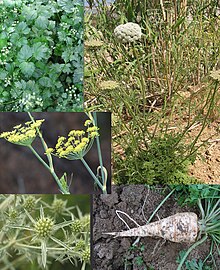Umbelliferous
| Carrot family | |
|---|---|
 |
|
| Umbelliferae: Apium leaves and tiny inflorescences, Daucus habit, Foeniculum inflorescences, Eryngium inflorescences, Petroselinum root. | |
| Scientific classification | |
| Kingdom: | Plantae |
| (unranked): | Angiosperms |
| (unranked): | Eudicots |
| (unranked): | Asterids |
| Order: | Apiales |
| Family: |
Apiaceae (or Umbelliferae) Lindl. |
| Type genus | |
|
Apium L. |
|
| Subfamilies | |
|
|
Apiaceae or Umbelliferae, is a family of mostly aromatic flowering plants commonly known as the celery, carrot or parsley family. The family, which is named after the type genus Apium, is large, with more than 3,700 species spread across 434 genera; it is the 16th-largest family of flowering plants. Included in this family are the well-known plants: angelica, anise, arracacha, asafoetida, caraway, carrot, celery, Centella asiatica, chervil, cicely, coriander (cilantro), culantro, cumin, dill, fennel, hemlock, lovage, cow parsley, parsley, parsnip, cow parsnip, sea holly, giant hogweed and silphium (a plant whose identity is unclear and which may be extinct).
Most Apiaceae are annual, biennial or perennial herbs (frequently with the leaves aggregated toward the base), though a minority are shrubs or trees. Their leaves are of variable size and alternately arranged, or alternate with the upper leaves becoming nearly opposite. In some taxa, the texture is leathery, fleshy, or even rigid, but always with stomata. They are petiolate or perfoliate and more or less sheathing, the blade usually dissected and pinnatifid, but entire in some genera. Most commonly, crushing their leaves emits a marked smell, aromatic to foetid, but absent in some members. The flowers are nearly always aggregated in terminal umbels, simple or compound, often umbelliform cymes, rarely in heads.
...
Wikipedia
